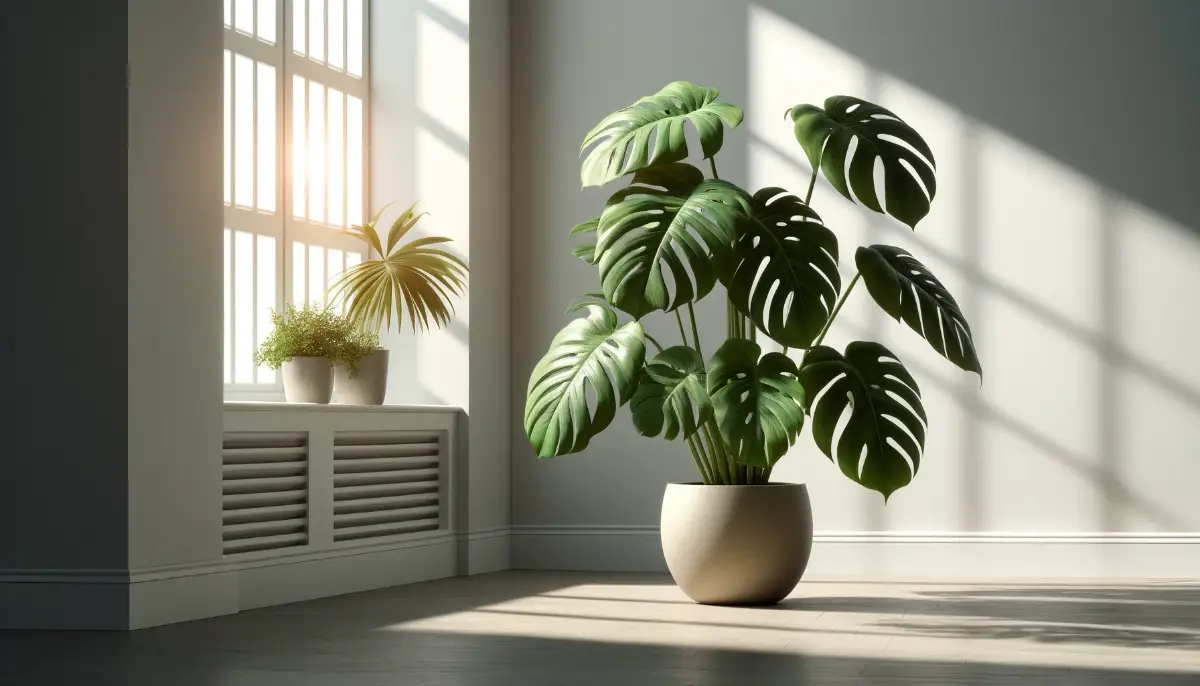Calathea Orbifolia is a popular houseplant admired for its large, round leaves with silver and green stripes. Native to Bolivia’s tropical forests, it thrives in warm, humid conditions with indirect light.
Although it requires specific care, including consistent humidity, proper watering, and well-draining soil, the effort is worthwhile for its stunning foliage. This guide provides essential tips on creating the ideal environment, maintaining proper care routines, and addressing common issues, helping you keep your Calathea Orbifolia healthy and beautiful.
Choosing the Right Environment
Light Requirements
- Indirect, Bright Light: Place your Calathea Orbifolia in a spot where it receives plenty of indirect light. Direct sunlight can scorch its delicate leaves.
- Avoid Direct Sunlight: Direct sun exposure can cause leaf burn and fade the plant’s vibrant colors.
Temperature and Humidity
- Optimal Temperature: Maintain a temperature range of 65-75°F (18-24°C). Keep the plant away from drafts and sudden temperature changes.
- High Humidity: This plant thrives in high humidity environments. Aim for at least 60% humidity.
Tips for Maintaining Humidity:
- Use a humidifier nearby.
- Place the pot on a tray filled with pebbles and water.
- Regularly mist the leaves with distilled water.
Creating the right environment is crucial for the health and growth of your Calathea Orbifolia. Proper light, temperature, and humidity levels will ensure that your plant remains vibrant and thriving.
Planting Calathea Orbifolia
Soil Requirements
- Well-Draining Soil Mix: Use a soil mix that provides good drainage while retaining some moisture.
- Suggested Soil Components: A mix of peat, perlite, and potting soil works well.
Pot Selection
- Drainage Holes: Ensure the pot has drainage holes to prevent water from accumulating at the bottom, which can lead to root rot.
- Pot Size: Choose a pot that is slightly larger than the root ball of the plant. This gives the roots room to grow without being too large, which can lead to overwatering issues.
Proper planting is essential for the health of your Calathea Orbifolia. Using the right soil mix and pot will help ensure the plant receives the appropriate amount of water and nutrients.
Watering Calathea Orbifolia
Watering Frequency
- Consistent Watering: Keep the soil consistently moist but not waterlogged. Water when the top inch of soil feels dry to the touch.
- Avoid Overwatering: Ensure the pot has good drainage to prevent water from sitting at the bottom and causing root rot.
Water Quality
- Use Distilled or Rainwater: Calathea Orbifolia is sensitive to chemicals in tap water, such as chlorine and fluoride. Using distilled or rainwater can help prevent leaf browning and other issues.
- Avoid Hard Water: If using tap water, let it sit out overnight to allow chemicals to dissipate or use a water filter.
Proper watering is crucial for maintaining the health of your Calathea Orbifolia. Ensuring the right frequency and quality of water will help keep the plant vibrant and thriving.
Organic Feeding for Calathea Orbifolia
Fertilization Schedule
- Monthly Feeding: Feed your Calathea Orbifolia once a month during the growing season (spring and summer).
- Skip Winter: Reduce or stop feeding during the fall and winter months when the plant’s growth slows down.
Types of Organic Fertilizers
- Compost Tea: A diluted solution made from compost can provide essential nutrients.
- Worm Castings: Incorporate worm castings into the top layer of soil for a slow-release nutrient boost.
- Fish Emulsion: Use a diluted fish emulsion for a quick and easy organic feed.
Using organic fertilizers ensures your Calathea Orbifolia receives natural nutrients without the risk of chemical buildup in the soil, promoting healthier growth and a more sustainable gardening practice.
Pruning and Maintenance for Calathea Orbifolia
Removing Dead or Yellowing Leaves
- Tools Needed: Use clean, sharp scissors or pruning shears to avoid damaging the plant.
- How to Prune: Trim dead or yellowing leaves at the base to encourage new growth and maintain the plant’s appearance.
Dusting Leaves
- Importance: Keeping leaves free of dust ensures they can photosynthesize effectively.
Methods:
- Soft Cloth: Wipe leaves gently with a damp, soft cloth.
- Misting: Lightly mist the leaves and then wipe them clean.
Regular pruning and maintenance help keep your Calathea Orbifolia healthy and looking its best. Removing dead foliage and keeping the leaves clean promotes better growth and overall plant health.
Repotting Calathea Orbifolia
When to Repot
- Signs it Needs Repotting: Look for roots coming out of the drainage holes, slow growth, or soil that dries out too quickly.
- Frequency: Generally, repot every 1-2 years during the growing season (spring or early summer).
How to Repot
- Prepare the New Pot: Choose a pot 1-2 inches larger in diameter than the current one, with good drainage holes.
- Remove the Plant: Gently remove the plant from its current pot, being careful not to damage the roots.
- Inspect and Trim Roots: Check for any dead or rotting roots and trim them with clean scissors.
- Add Fresh Soil: Place a layer of fresh, well-draining soil mix in the new pot.
- Position the Plant: Place the plant in the new pot, adding soil around the roots until the plant is securely positioned. Ensure the soil level remains the same as in the old pot.
- Water Thoroughly: Water the plant well after repotting to help it settle into its new home.
Repotting helps refresh the soil, providing the plant with new nutrients and more space for growth. This promotes overall health and vigor in your Calathea Orbifolia.
Propagation of Calathea Orbifolia
Division Method: The most effective way to propagate Calathea Orbifolia is by dividing the plant.
Steps for Successful Propagation
- Prepare the Tools: Gather a clean, sharp knife or scissors, fresh potting mix, and suitable pots.
- Remove the Plant from Its Pot: Gently take the plant out of its pot, being careful not to damage the roots.
- Locate Natural Divisions: Look for natural separations in the root ball where new shoots have formed.
- Divide the Plant: Use the knife or scissors to carefully separate the plant into smaller sections, ensuring each division has roots and at least one healthy shoot or leaf.
- Plant the Divisions: Place each division into a pot filled with fresh, well-draining potting mix. Position the plant in the center and fill in around the roots with soil.
- Water the New Plants: Water thoroughly to help the plants settle in. Maintain consistent moisture but avoid waterlogging.
Propagating by division is a straightforward method that can yield multiple healthy plants from a single Calathea Orbifolia. This method is best performed during the growing season to ensure the new plants establish well.
Seasonal Care for Calathea Orbifolia
Spring and Summer
- Increased Watering: Water more frequently as the plant is actively growing. Ensure the soil remains consistently moist but not waterlogged.
- Regular Feeding: Apply organic fertilizer monthly to support growth.
- Humidity Maintenance: Maintain high humidity levels, using a humidifier or misting regularly.
Fall
- Gradual Water Reduction: Begin to reduce the frequency of watering as the plant’s growth slows down.
- Stop Feeding: Discontinue fertilization as the plant enters its dormant phase.
- Humidity Adjustment: Continue to monitor humidity levels, especially if indoor heating systems dry out the air.
Winter
- Minimal Watering: Water sparingly, only when the top inch of soil is dry. Be careful not to overwater.
- Avoid Drafts: Keep the plant away from cold drafts and direct contact with heating sources.
- Maintain Humidity: Use a humidifier or pebble tray to maintain adequate humidity, as indoor air tends to be drier in winter.
Seasonal care adjustments help ensure that your Calathea Orbifolia thrives throughout the year by aligning care practices with its natural growth cycle and environmental changes.
Common Problems and Solutions for Calathea Orbifolia
Yellowing Leaves
- Cause: Overwatering or poor drainage.
- Solution: Check the soil moisture and ensure the pot has proper drainage. Allow the soil to dry slightly between waterings.
Browning Leaf Edges
- Cause: Low humidity, underwatering, or use of tap water containing chlorine or fluoride.
- Solution: Increase humidity using a humidifier or pebble tray, water regularly, and use distilled or rainwater.
Curling Leaves
- Cause: Underwatering, low humidity, or cold drafts.
- Solution: Ensure consistent watering, maintain high humidity, and keep the plant away from drafts.
Faded or Scorched Leaves
- Cause: Exposure to direct sunlight.
- Solution: Move the plant to a spot with bright, indirect light.
Pests
- Common Pests: Spider mites, aphids, mealybugs.
- Solution:
- Natural Treatments: Spray with a mixture of water and mild dish soap, or use neem oil.
- Chemical Treatments: Use insecticidal soap or horticultural oil as needed.
Root Rot
- Cause: Overwatering or poor drainage.
- Solution: Reduce watering frequency, improve drainage by using well-draining soil and pots with drainage holes, and remove affected roots if necessary.
Leaf Spot
- Cause: Fungal or bacterial infections.
- Solution: Remove affected leaves, improve air circulation around the plant, and avoid overhead watering.
By addressing these common problems promptly and adjusting care practices accordingly, you can help ensure your Calathea Orbifolia remains healthy and vibrant.
FAQs about Calathea Orbifolia
How often should I water my Calathea Orbifolia?
Water your Calathea Orbifolia when the top inch of soil feels dry. Keep the soil consistently moist but not waterlogged, and reduce watering in the winter.
What type of light does Calathea Orbifolia need?
Calathea Orbifolia thrives in bright, indirect light. Avoid direct sunlight as it can scorch the leaves and cause them to fade.
How can I increase humidity for my Calathea Orbifolia?
Increase humidity by using a humidifier, placing the pot on a pebble tray with water, or misting the leaves regularly with distilled water.
What is the best soil mix for Calathea Orbifolia?
Use a well-draining soil mix, such as a combination of peat, perlite, and potting soil, to ensure proper drainage and moisture retention.
Why are the edges of my Calathea Orbifolia’s leaves turning brown?
Brown leaf edges can result from low humidity, underwatering, or exposure to tap water with chlorine or fluoride. Increase humidity, ensure regular watering, and use distilled or rainwater.
How often should I fertilize my Calathea Orbifolia?
Fertilize monthly during the growing season (spring and summer) with an organic fertilizer. Do not fertilize in the fall and winter when the plant’s growth slows down.
When and how should I repot my Calathea Orbifolia?
Repot your Calathea Orbifolia every 1-2 years in the spring or early summer. Choose a pot that is 1-2 inches larger in diameter, and use fresh, well-draining soil.
How do I propagate Calathea Orbifolia?
Propagate Calathea Orbifolia by division. Separate the plant into smaller sections, ensuring each division has roots and at least one healthy shoot, and plant each section in fresh soil.
What should I do if my Calathea Orbifolia has pests?
Treat pests like spider mites, aphids, and mealybugs with natural remedies such as water and mild dish soap spray or neem oil. For severe infestations, use insecticidal soap.
Why are my Calathea Orbifolia’s leaves curling?
Leaf curling can be caused by underwatering, low humidity, or cold drafts. Ensure consistent watering, maintain high humidity, and keep the plant away from drafts.









